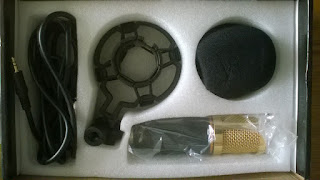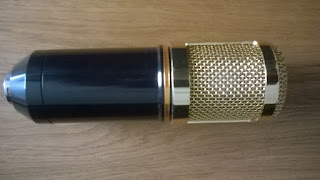 BM-800 Mic something to talk about.
BM-800 Mic something to talk about.
The BM-800 microphone has been around for a few years, search ebay and an abundance of them will flood your screen. The BM-800 and 700 versions are produced in China, the BM-700 version only has slight cosmetic differences but is basically the same. The BM-800 is well constructed for a price of around £10 "including delivery" putting most expensive commercial microphones to shame for price! Infact you could buy a score of BM-800's to one well known branded studio microphone.
Until recently there were two types of the BM-800 available, one version was badged Shengyue BM-800, this had the advantage of an onboard 1.5V battery to feed the condenser insert. Thus the great advantage of this no external supply was required. This model has now become as rare as hens teeth and we are left with the 48V version. This type however requires an external 48V voltage fed up the cable to charge the insert. Some have overcome this problem using the microphone with an external audio mixer and feeding it using the 48V phantom power supply from the mixer. There is also another problem, the audio output is balanced, and again if not using a mixer you have got to find a method of changing it's output to unbalanced to feed your rig.
I have a couple of these microphones still wrapped up in their boxes and have been thinking for sometime how I could match them straight into my radio's without using a mixer etc.
Until recently there had been very few modification ideas around for this model, but a few nights ago I stumbled across a website from Pete G4IZH who has not only done all that is required to convert the mic from 48V to around 9V that can be taken from your radio's external mic socket supply, or even using a 9V battery, which could be made to fit inside the BM-800 case. The board has then been hacked, to get rid of the balanced output and then fed directly into a filter to tame the HF and LF response ranges, making it more ideal for Amateur requirements. Of course you don't have to do it quite the same, especially if you want to fit a PP3 battery inside the case a bit more room will be required, but all the information is now there to customize the idea to your own requirements.
Reference G4IZH BM-800 modifications here
Steve, G1KQH, is a regular contributor to AmateurRadio.com and writes from England. Contact him at [email protected].Until recently there were two types of the BM-800 available, one version was badged Shengyue BM-800, this had the advantage of an onboard 1.5V battery to feed the condenser insert. Thus the great advantage of this no external supply was required. This model has now become as rare as hens teeth and we are left with the 48V version. This type however requires an external 48V voltage fed up the cable to charge the insert. Some have overcome this problem using the microphone with an external audio mixer and feeding it using the 48V phantom power supply from the mixer. There is also another problem, the audio output is balanced, and again if not using a mixer you have got to find a method of changing it's output to unbalanced to feed your rig.
I have a couple of these microphones still wrapped up in their boxes and have been thinking for sometime how I could match them straight into my radio's without using a mixer etc.
Until recently there had been very few modification ideas around for this model, but a few nights ago I stumbled across a website from Pete G4IZH who has not only done all that is required to convert the mic from 48V to around 9V that can be taken from your radio's external mic socket supply, or even using a 9V battery, which could be made to fit inside the BM-800 case. The board has then been hacked, to get rid of the balanced output and then fed directly into a filter to tame the HF and LF response ranges, making it more ideal for Amateur requirements. Of course you don't have to do it quite the same, especially if you want to fit a PP3 battery inside the case a bit more room will be required, but all the information is now there to customize the idea to your own requirements.
Reference G4IZH BM-800 modifications here
















